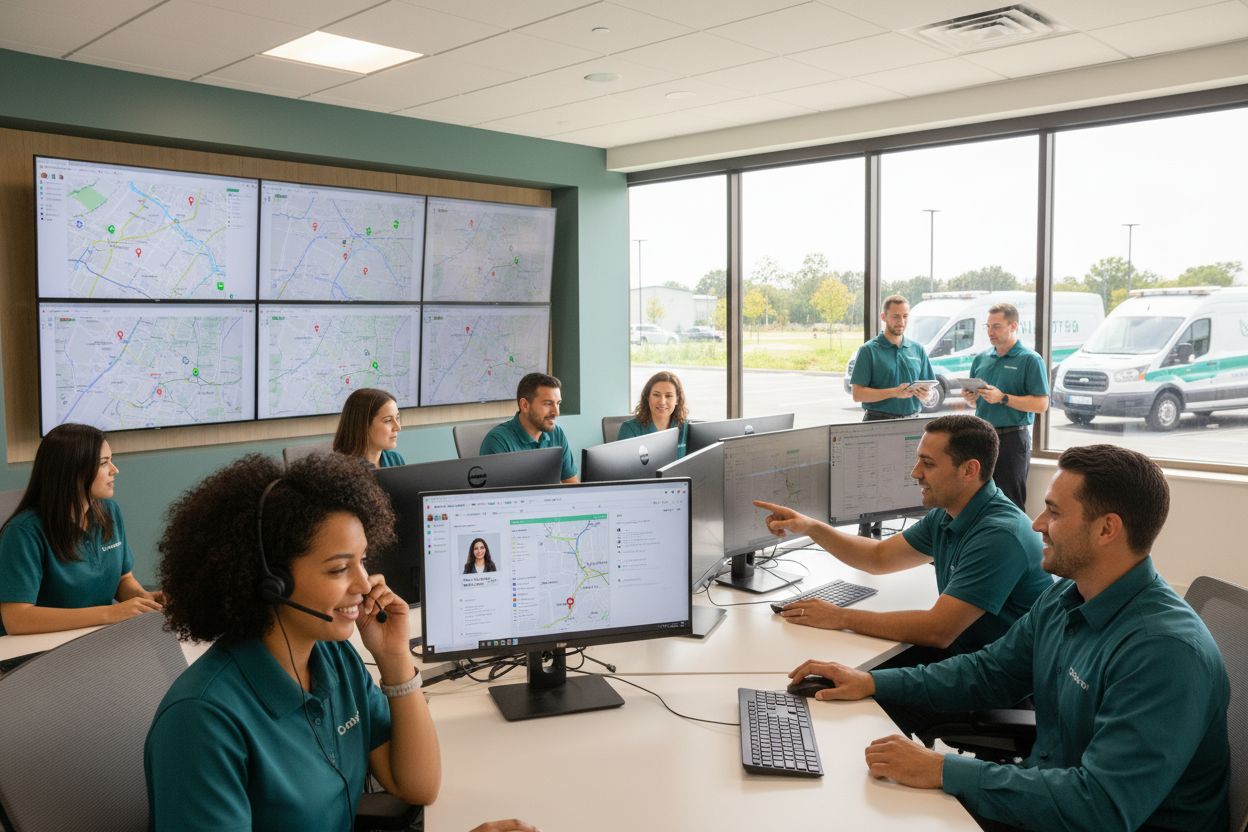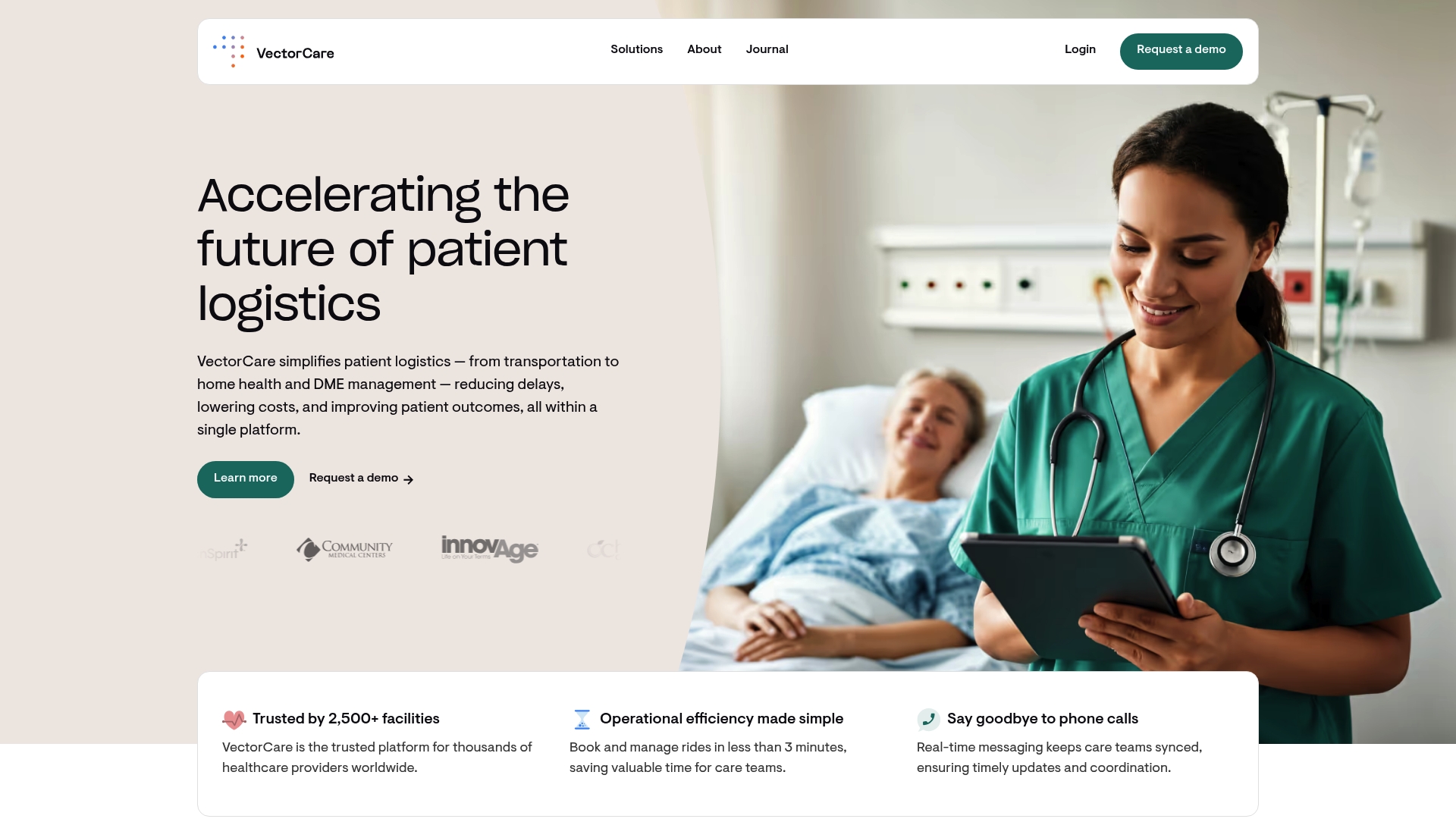7 Essential Digital Strategies for NEMT Providers

Did you know that smart scheduling tools can reduce manual planning time for non emergency medical transportation by about 40 percent? As more patients rely on timely, safe rides to medical appointments, providers face growing pressure to deliver efficient, reliable service. Adopting the right mix of automation, real time communication, and data driven decision making helps transportation teams keep pace with demand, improve patient care, and cut operational costs.
Quick Summary
| Takeaway | Explanation |
|---|---|
| 1. Automate Ride Scheduling | Automation can cut manual scheduling time by 40% and increase trip volume by 25%. |
| 2. Utilize Real-Time Communication | Instant updates improve patient experience and reduce no-show rates. |
| 3. Optimize Routes with AI | AI can enhance fleet efficiency by 20-30% and reduce costs effectively. |
| 4. Centralized Vendor Management | Unified platforms streamline operations and improve coordination among vendors. |
| 5. Ensure Data Compliance | Implement advanced security measures to protect patient information and comply with HIPAA regulations. |
Table of Contents
- Automate Ride Scheduling To Save Time
- Use Real-Time Communication For Updates
- Optimize Routes With Ai-Driven Dispatching
- Manage Vendors Through A Centralized Platform
- Integrate With Health Systems Securely
- Use Data Insights To Improve Performance
- Ensure Compliance And Protect Patient Data
1. Automate Ride Scheduling to Save Time
Non emergency medical transportation (NEMT) providers face constant pressure to optimize their scheduling processes while maintaining high quality patient care. Automated ride scheduling represents a transformative strategy that can dramatically improve operational efficiency and service delivery.
Artificial intelligence powered scheduling solutions now enable NEMT providers to match drivers, vehicles, and patient requirements with unprecedented precision. According to research from industry experts, AI scheduling can reduce manual planning time by approximately 40% and increase trip volume by 25%. This means more patients transported, less administrative overhead, and significantly improved response times.
The core advantage of automation lies in its ability to handle complex routing challenges instantly. Intelligent systems analyze multiple variables simultaneously such as patient pickup locations, vehicle availability, driver credentials, time windows, and special patient needs. These systems can adjust routes in real time, responding to unexpected changes like traffic delays or last minute cancellations.
Implementing automated scheduling requires strategic steps:
- Select a solution with robust AI capabilities
- Ensure seamless integration with existing dispatch systems
- Train staff on new technological workflows
- Monitor performance metrics consistently
By exploring our guide on effective round trip ride scheduling, providers can gain deeper insights into maximizing their scheduling strategies. The goal is not just efficiency but creating a more responsive, patient centered transportation ecosystem.
2. Use Real-Time Communication for Updates
Effective communication is the backbone of exceptional non emergency medical transportation services. Real-time updates transform patient transportation from a passive experience to an interactive and transparent journey that keeps everyone informed and engaged.
Modern AI powered platforms now enable instantaneous communication across all stakeholders. According to research, these systems provide dynamic notifications that track every stage of transportation. Patients, clinics, dispatchers, and drivers receive immediate updates about route progress, potential delays, and precise arrival times.
Real-time communication offers multiple strategic advantages for NEMT providers. By proactively sharing information, organizations can significantly reduce uncertainty and anxiety associated with medical transportation. Research indicates that immediate notifications help minimize no-show rates and improve overall patient experience.
Implementing robust real-time communication requires several key strategies:
- Integrate mobile app tracking capabilities
- Establish automated notification systems
- Create clear communication protocols
- Train staff on effective digital communication
For healthcare providers seeking to enhance their communication infrastructure, The Current State of NEMT Scheduling in Hospitals offers comprehensive insights into developing more responsive transportation networks. By prioritizing transparent, instantaneous communication, NEMT providers can dramatically improve service quality and patient satisfaction.
3. Optimize Routes with AI-Driven Dispatching
Route optimization is the secret weapon for modern non emergency medical transportation providers seeking maximum efficiency. Traditional manual dispatching methods are rapidly becoming obsolete as artificial intelligence transforms how transportation networks operate.
AI-driven dispatching uses sophisticated algorithms to analyze complex routing challenges in real time. According to recent research, these intelligent systems can improve fleet efficiency by 20 to 30 percent and significantly reduce operational costs. By processing multiple variables simultaneously—including traffic patterns, patient locations, vehicle availability, and time constraints—AI can recalculate optimal routes instantaneously.
The financial and operational benefits of AI dispatching are substantial. Research indicates these systems can cut fuel consumption by approximately 30 percent while simultaneously increasing on time performance. Transportation providers adopting AI technologies report handling up to 34 percent more trips without proportionally increasing staff or vehicle resources.
Implementing AI-driven route optimization requires strategic approaches:
- Select advanced dispatching platforms with machine learning capabilities
- Integrate comprehensive data sources
- Train staff on new technological workflows
- Continuously monitor and refine routing strategies
For healthcare organizations seeking deeper insights, 5 Reasons to Improve Healthcare Dispatching offers comprehensive strategies for leveraging technology in patient transportation networks.
4. Manage Vendors Through a Centralized Platform
Vendor management in non emergency medical transportation is evolving from fragmented processes to streamlined digital ecosystems. Modern healthcare organizations require sophisticated platforms that can unify multiple operational functions and stakeholder interactions.
AI powered cloud based platforms now enable comprehensive vendor management by integrating dispatch, scheduling, billing, broker communication, and driver coordination into a single unified system. Research indicates these centralized solutions dramatically reduce administrative complexity and improve operational coordination across diverse transportation networks.
Centralized platforms transform vendor relationships by providing unprecedented visibility and control. Cloud based dispatch solutions allow healthcare providers to automate trip requests, enhance communication protocols, and create transparent tracking mechanisms. By consolidating vendor interactions into one intelligent platform, organizations can scale operations without proportionally increasing administrative staff.
Implementing a centralized vendor management approach requires strategic considerations:
- Select platforms with robust integration capabilities
- Ensure comprehensive data security measures
- Develop clear communication protocols
- Create standardized performance evaluation metrics
- Train staff on new technological workflows
For healthcare leaders seeking deeper insights, Understanding Healthcare Vendor Management and Its Importance offers comprehensive strategies for modernizing vendor engagement in patient transportation networks.
5. Integrate with Health Systems Securely
Secure integration between non emergency medical transportation platforms and healthcare systems represents the future of patient centered logistics. Modern healthcare requires seamless communication that protects sensitive patient information while enabling real time data exchange.
Advanced integration technologies like Fast Healthcare Interoperability Resources (FHIR) standards now enable NEMT providers to connect directly with electronic health record systems. These sophisticated APIs allow secure transmission of critical patient information including demographics, mobility requirements, and appointment details. By eliminating manual data entry processes, providers can dramatically reduce administrative errors and improve overall scheduling accuracy.
Cloud based dispatch systems transform healthcare coordination by creating intelligent information networks. Automated systems can now receive appointment details, provide real time transport status updates, and streamline insurance billing processes. These integrations create a comprehensive ecosystem where patient transportation becomes a seamless extension of medical care delivery.
Successful health system integration requires strategic implementation:
- Select platforms with robust HIPAA compliant security protocols
- Utilize standardized healthcare communication frameworks
- Implement comprehensive staff training programs
- Develop clear data sharing agreements
- Regularly audit integration performance
Healthcare leaders seeking deeper insights can explore Top Healthcare Cybersecurity Best Practices for Providers to understand the critical nuances of secure medical communication technologies.
6. Use Data Insights to Improve Performance
Data has become the most powerful strategic asset for non emergency medical transportation providers seeking operational excellence. Modern GPS enabled platforms and artificial intelligence technologies now transform raw transportation information into actionable strategic insights.
Advanced AI platforms automatically collect and analyze comprehensive trip data, providing unprecedented visibility into operational performance. These intelligent systems can track critical metrics including on time performance, route efficiency, driver productivity, and resource utilization. By converting complex data streams into clear visual analytics, providers can make informed decisions that dramatically improve service quality and reduce operational costs.
Strategic data analysis enables unprecedented operational optimization. Research indicates that GPS software with visual analytics can help providers reduce costs by 30 to 70 percent and minimize patient wait times from over 30 minutes to under 10 minutes. These powerful insights allow transportation networks to allocate resources more effectively, identify potential bottlenecks, and continuously refine their service delivery models.
Implementing a comprehensive data insights strategy requires systematic approaches:
- Select platforms with robust reporting capabilities
- Establish clear performance measurement frameworks
- Train staff on data interpretation techniques
- Create regular performance review processes
- Develop continuous improvement protocols
For healthcare leaders seeking deeper understanding, Healthcare Data Insights for Providers and Agencies 2025 offers comprehensive strategies for transforming operational data into strategic advantage.
7. Ensure Compliance and Protect Patient Data
Patient data protection represents the most critical responsibility for non emergency medical transportation providers in the digital age. Healthcare organizations must navigate complex regulatory landscapes while maintaining the highest standards of data security and privacy.
Compliance with Health Insurance Portability and Accountability Act (HIPAA) regulations requires a multifaceted approach that goes far beyond basic security protocols. Modern NEMT providers must implement sophisticated technological safeguards including secure encryption, role based access controls, comprehensive audit trails, and continuous staff training. Artificial intelligence powered platforms now offer advanced capabilities to automatically monitor and protect sensitive patient health information.
Strategic data protection involves creating multiple layers of security across technological and human systems. Research indicates that effective compliance requires implementing immutable audit logs, secure mobile applications with encryption, session timeouts, and multi factor authentication. These technological measures prevent unauthorized access and support comprehensive audit readiness.
Developing a robust compliance strategy requires systematic implementation:
- Conduct regular security risk assessments
- Implement advanced encryption technologies
- Create comprehensive staff training programs
- Develop clear data access and management protocols
- Establish continuous monitoring systems
Healthcare leaders seeking deeper insights can explore Understanding HIPAA Compliance for Home Health Care to gain a more nuanced understanding of protecting patient information in complex healthcare ecosystems.
Below is a comprehensive table summarizing the key strategies for optimizing non-emergency medical transportation (NEMT) operations as discussed in the article.
| Strategy | Implementation | Expected Results |
|---|---|---|
| Automate Ride Scheduling | Select AI solutions, integrate with dispatch, train staff. | Reduce planning time by 40%, increase trips by 25%. |
| Use Real-Time Communication | Integrate mobile tracking, set up notifications, train on digital communication. | Decrease no-shows, enhance patient experience with proactive updates. |
| Optimize Routes with AI | Choose AI dispatch platforms, use real-time analysis, train staff. | Boost fleet efficiency by 20-30%, cut fuel costs by 30%. |
| Centralize Vendor Management | Use cloud platforms, ensure integration, train staff. | Streamline operations, improve coordination, reduce admin complexity. |
| Integrate with Health Systems | Adopt FHIR standards, ensure HIPAA compliance, train staff. | Secure data sharing, improve accuracy, streamline processes. |
| Use Data Insights | Implement robust reporting, establish performance metrics. | Reduce costs 30-70%, improve resource allocation. |
| Ensure Compliance | Conduct risk assessments, use encryption, train staff. | Protect patient data, meet HIPAA requirements. |
Transform NEMT Operations With VectorCare’s All-In-One Digital Platform
Are you struggling with outdated scheduling, fragmented vendor management, or constant communication breakdowns in your non emergency medical transportation network? The article highlights how automation, real-time updates, and secure integrations can completely change the way you deliver care. But achieving these results requires more than just understanding the challenges. It calls for a solution designed for the demands of today’s healthcare logistics.

With VectorCare, you get a secure, no-code digital platform built specifically for healthcare organizations who want to optimize ride scheduling, integrate with health systems, and simplify compliance. Experience automated ride scheduling, AI-driven dispatching, and advanced data insights—all in one place. Improve outcomes for patients, reduce costs for your team, and dramatically boost your operational efficiency. Ready to see these digital strategies in action? Visit VectorCare’s website and schedule a personalized demo today to take your NEMT operations to the next level.
Frequently Asked Questions
How can I automate ride scheduling for my NEMT service?
Automate ride scheduling by integrating an AI-powered scheduling solution. This can reduce manual planning time by about 40%, allowing you to maximize efficiency and improve response times.
What steps should I take to implement real-time communication for NEMT?
Implement real-time communication by integrating a mobile app that provides dynamic notifications about trip statuses. Establish clear communication protocols and train your staff on how to utilize these new systems effectively.
How does AI-driven dispatching improve routing for NEMT providers?
AI-driven dispatching uses algorithms to analyze routing challenges and optimize routes in real time. Start by selecting a dispatch platform that incorporates machine learning, which can enhance fleet efficiency by up to 30%.
What should I consider when managing vendors for NEMT services?
Consider centralizing vendor management through a comprehensive platform that integrates all operational functions. This approach simplifies processes and improves visibility, which can help streamline communication and reduce administrative complexity.
How can I securely integrate my NEMT platform with health systems?
Securely integrate your NEMT platform by choosing a system that adheres to HIPAA compliance and utilizes APIs for smooth data sharing. Conduct regular audits to ensure that patient information is protected and integration performance is optimized.
What types of data insights can improve my NEMT performance?
Data insights like trip efficiency and driver productivity can significantly impact your NEMT performance. Use platforms that provide visual analytics to make informed decisions, potentially reducing costs by 30% to 70%.



